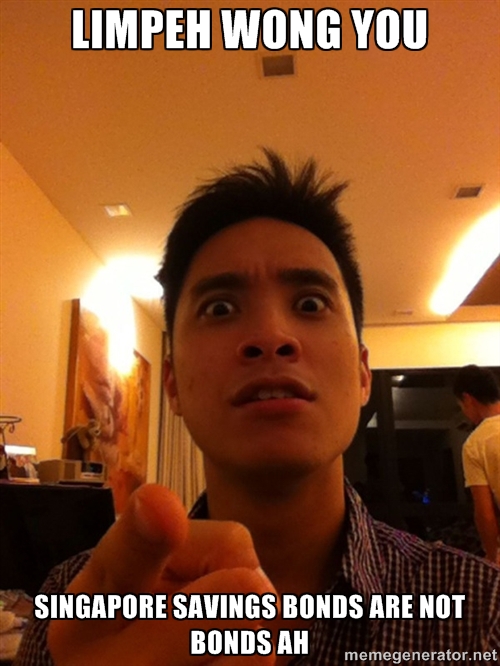 Let me just put it out there: Pitch Perfect 2 is an awesome movie.
Let me just put it out there: Pitch Perfect 2 is an awesome movie.
Sure, the plot was thin and the lines were cheesy. But admit it: you were bopping your head to those remixed songs during the movie, weren’t you?
Embarrassing confession: Sometimes, I play the Pitch Perfect soundtrack when I get ready for work in the mornings. I know, I sound totally macho right now.
Anywayyyyys, Pitch Perfect 2 opened on the same week as another big announcement in the personal finance world: The Singapore Savings Bonds (SSBs).
Loooooots of people were talking about it. It was pretty cool. I’m not gonna repeat what my fellow bloggers have already mentioned, because you can find some excellent articles here, here and here. (As usual, I’m about 2 weeks late when it comes to blogging about these things)
BUT! After getting some questions on the SSBs, I feel deeply obligated to correct a pretty big misconception around them. And what better way to do this than to use Pitch Perfect 2 as an analogy?
Prepare to get aca-ducated.
Don’t Forget The Category
One of my favourite scenes in Pitch Perfect 2 was the “riff-off”: A badass acapella battle where groups have to sing impromptu songs within a certain category. Here’s a scene from part of it:
It’s down to the last 2 teams and the Barden Bellas are battling their arch nemesis, Das Sound Machine. Their category? “90s Hip-Hop Jamz.”
Das Sound Machine draws first blood with the classic “This Is How We Do It”, and the Bellas counter with a rendition of “That Thing”. DSM hits back with Bell Biv DeVoe’s “Poison”, to which Fat Amy retorts with the chorus of “Scenario”. Undeterred, DSM confidently returns the serve with “Insane In The Brain”.
But the battle comes to a screeching halt when the Bellas’ newest member Emily sings her own original song “Flashlight.” It’s a great song (I almost teared up at the end when they sung it again), but it wasn’t relevant to the category.
Emcee: I’m sorry, what 90s hip-hop jam is that again?
Emily: Uhhhhh… more like, a 21st century jam. That’s it… Yep. I wrote it.
Boom. The Bellas lose the riff-off.
That’s what happens when you try fit a good thing into the wrong category.
Why The Singapore Savings Bonds Aren’t “Investments”
Similarly, a lot of people have been asking me how they can “invest” in the Singapore Savings Bonds. Their logic:
“SSBs = better yield = good investment… right?”
Noooooooooo. Classifying the SSBs as an “investment” is like singing a song that’s completely irrelevant to the category.
You can’t blame the public for being confused – the name “Singapore Savings Bond” is kinda misleading. You see: the Singapore Savings Bonds aren’t really bonds!!
I know. It’s crazy. It makes me wanna take out a big billboard on Orchard Road that looks like this:
So if they’re not bonds, what are they?
The Singapore Savings Bonds are actually more like fixed deposits (FDs). Check out this great article from Big Fat Purse which explains why. Don’t worry – I’ll wait.
Back? Awesome! So, pop quiz: What should you use FDs for?
The answer: SAVINGS! Not investments… savings!
In other words, you should be using the SSBs to park money for things like:
- The house downpayment you’re gonna make in 3 years
- Your kid’s education when she enters university in 5 years
- The MBA you’re gonna take up when you take a break from work in 2 years
This is money that you’re gonna spend in the short to medium-term, so you can’t afford to take a lot of risk with them. Therefore, you SHOULD park them in the Singapore Savings Bonds since they’re pretty much just like another form of fixed deposit.
This is very different from your investments – which is where you’ll want to put your long-run funds: Money that you won’t touch for the next 10, 20, 30 years. Moolah that’s meant for big dreams, like an island in Dubai or a mansion made of Maggie Mee (or whatever else floats your boat).
Soooooo – how should you be thinking about your investments?
It’s About Harmony, Not Just Yield
 Think about how acapella groups work: They have their sopranos and the altos and basses and a cool beatboxer. Some singers sing high, and some of ‘em sing low. And a combination of those differences produces harmony.
Think about how acapella groups work: They have their sopranos and the altos and basses and a cool beatboxer. Some singers sing high, and some of ‘em sing low. And a combination of those differences produces harmony.
So there’s one important distinction between the SSBs and regular bonds: SSBs don’t fluctuate at all, while bonds do. Many people think that fluctuations are “bad”, but they actually help to harmonise a portfolio.
Think about it: Bonds tend to move in the opposite direction from stocks. In other words, bonds usually zig when stocks zag. Bonds sing low when stocks sing high. Bonds rise to the occasion when stocks fall flat on their face.
That means when you own BOTH stocks and bonds, they counterbalance each other and make investing a much smoother ride. This is also called “diversification”.
SSBs, on the other hand, don’t fluctuate. They may pay you a nice interest rate every 6 months, but they don’t move up and down. it’s like recruiting a singer who can only sing flat tunes.
That’s why you shouldn’t be looking to “invest” in the SSBs. Keep them for your savings and don’t mix up the two.
When it comes to your investment portfolio, nothing balances out your stocks better than good ol’ bonds (or a simple bond ETF).
The Aca-Summary
So! Three quick things that I want you to take away today:
- Use the Singapore Savings Bonds for your savings,not investments
- Instead, use bonds / bond ETFs to harmonise your investment portfolio
- Pitch Perfect has pretty awesome songs.
Cool right? You learnt something new today!
Now, Imma go back to jamming out to acapella songs on YouTube. Aca-scuse me!
Image credits: hovgo, Peter E. Lee

[…] By Lionel Yeo […]